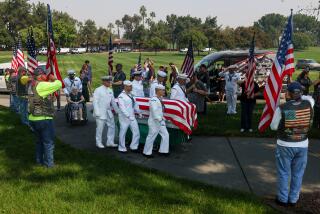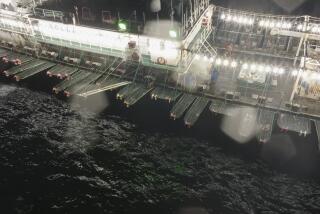Horror of Soviet Nuclear Sub’s ’61 Tragedy Told
- Share via
MURMANSK, Russia — After that nightmare voyage 33 years ago, Ivan Kolokov stopped shaving. The skin on his face kept peeling off with the razor. Nikolai Zateyev, his shipmate, lay in bed 18 months while doctors replaced his bone marrow and blood.
Both sailors consider themselves lucky when they remember Boris Korchilov.
Korchilov was a blue-eyed, 20-year-old ladies’ man. Before the voyage he was playing volleyball and flirting. The next week he was writhing in agony, sweating blood, his face swollen beyond recognition. A week later he was buried in a secret communal grave.
Korchilov, Zateyev, Kolokov and 136 other men were sailors aboard the K-19, a Soviet nuclear submarine whose reactor went haywire in 1961. Zateyev, the captain, sent 22 volunteers to their deaths in a heroic struggle to save the boat.
The men won that struggle; the reactor did not explode. But the radiation made it a voyage from hell, with men dying in agony and begging their shipmates to kill them.
Before the breakup of the Soviet Union, the K-19’s fate was a closely guarded secret. Western specialists heard rumors but no details until 1991, when the newspaper Pravda finally confirmed that radiation had killed many members of the sub’s crew.
Crew members were sworn to secrecy. Even decades later, they were expected to lie to doctors in routine checkups.
For years, Russians knew the story of the K-19 only through underground songs. But the Soviet Union, the nation those sailors swore to defend, collapsed, and today the doomed vessel’s crew members are ready to flesh out those sad, romantic verses.
Capt. Zateyev, 67, and other survivors recounted their story in interviews in Moscow and the northern port of Murmansk.
Zateyev’s boat was the first Soviet atomic submarine armed with nuclear warheads. It was named the K-19, but among sailors it became known as “Hiroshima.”
The K-19 was a major technological advance for the Soviets. Engineers built her at a frenzied pace that took a deadly toll.
In 1959, an accidental explosion killed two workers. Soon after, six women died, overcome by fumes while gluing rubber lining into a water cistern.
For sailors, the most persuasive omen that the K-19 was a cursed boat came at the christening, when a champagne bottle struck across the bow bounced off unbroken.
“As in ancient Assyria, where a ship’s path to the water was slickened with the sacrificial blood of slaves, the launching ramp of the K-19 ran with human blood,” wrote Nikolai Cherkashin, a naval historian.
The frantic pace of construction led to sloppiness and shortcuts. Hurrying to finish, a welder let solder drip onto a pipe carrying coolant to the reactor. The pipe cracked microscopically, like a hot glass dropped into cold water. Engineers had installed no backup cooling system. The K-19’s mechanics complained about that but were told the reactor was “already too complex.”
All the same, the K-19 was the Rolls-Royce of the Soviet fleet, and Zateyev and his men, who had served only on diesel submarines until then, were thrilled to take the helm.
They were the elite of the fleet, and they knew it every time they sat down to dinner; they enjoyed delicacies other sailors only dreamed of--smoked fish, sausages, fine chocolates and cheeses.
On June 4, 1961, the K-19 was hiding in the North Atlantic from Soviet diesel subs as part of a training exercise. The cracked pipe burst.
In the reactor room, the temperature soared past 140 degrees Fahrenheit; the gauge went no higher. Radiation was also rising, but the crew could only guess by how much.
The reactor had to be cooled.
“It would have been Chernobyl, only 30 years earlier,” said crew member Alexander Fateyev, a retired captain who is now 56 and an official with the Russian Ministry of Energy.
He said the boat was carrying a second reactor and three nuclear warheads and would have poisoned the sea with radiation had the reactor burst.
Zateyev’s options were limited, a choice of evils.
“At one point, I thought of going down to my cabin, drawing my pistol and finishing all my problems at once,” he said.
Instead, he organized three-man brigades of volunteers to work for five to 10 minutes each. Protected only by raincoats and gas masks, they were ordered to weld together a new cooling system.
One of the first volunteers was Lt. Korchilov, the blue-eyed ladies’ man, a favorite of Zateyev’s.
“I accompanied him to the reactor room door--to his death,” Zateyev remembered. “And I said, ‘Well, Boris, do you know where you’re going?’
“And he said, ‘I know, comrade captain.’
Five minutes later, Korchilov stumbled out of the reactor room, tore off his gas mask and vomited.
“That was the first time I felt: ‘Yes, this is radiation,’ ” Zateyev said. Of the 139 crew members, 22 died of radiation poisoning--eight in a matter of days, the rest in the next two years.
“Right on the spot their appearances began changing. Skin not protected by clothing began to redden, face and hands began to swell. Dots of blood began to appear on their foreheads, under their hair. Within two hours we couldn’t recognize them,” Zateyev said. “People died fully conscious, in terrible pain. They couldn’t speak, but they could whisper. They begged us to kill them.”
The work brigades kept the reactor from exploding, and a Soviet diesel sub answered Zateyev’s SOS. The K-19 was towed to Polyarnyy, a port above the Arctic Circle on the Kola Peninsula. Korchilov and five other sailors were rushed to Moscow. A week later, Korchilov was the first to die; within 10 days, all six were dead.
Doctors told Zateyev that they had received three times the lethal dose of radiation.
Because the corpses themselves were dangerously radioactive, the six were buried secretly in a Moscow cemetery. Not even family and friends were notified.
Korchilov and his colleagues were so radioactive that everything they came in contact with at the hospitals had to be destroyed.
Two other sailors, flown to Leningrad--now St. Petersburg--for treatment, also died within a week and were buried there.
Others survived grueling treatments in Moscow and Leningrad hospitals.
The K-19 was gutted. Food stores, clothing, equipment and sailors’ possessions were stacked on a barge and moored off the Kola Peninsula. Signs declared the barge off-limits, but without explaining the danger.
Word spread to enlisted men on construction duty in nearby cities; they heard of an unguarded barge full of new boots, fine chocolates, fluffy towels and crates of vodka. In a matter of days, dawn broke on a near-empty barge.
“Who knows what became of those builders, once they’d sampled the delicacies of that damned barge,” Zateyev said.
A government commission declared the crew members of the K-19 heroes--mainly, Zateyev reasoned, to keep them from complaining in public.
They were ordered to keep secret what had happened, and their medical histories were falsified. Doctors wrote that they suffered from “damage to the peripheral nervous system.”
“Only a year or so ago did our doctors give us notices saying we had suffered from radiation exposure,” Zateyev said. “That was the system--hide everything. People suffered, died, and there was no reaction.”
As for the K-19, it was soon back in the water. In 1972, it was finally decommissioned at Polyarnyy, where it remains docked, after a fire on board killed 28 sailors.
More to Read
Sign up for Essential California
The most important California stories and recommendations in your inbox every morning.
You may occasionally receive promotional content from the Los Angeles Times.













